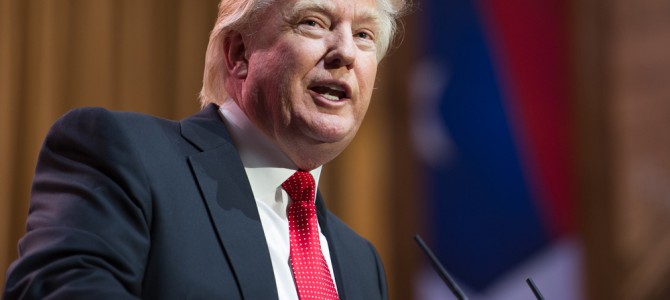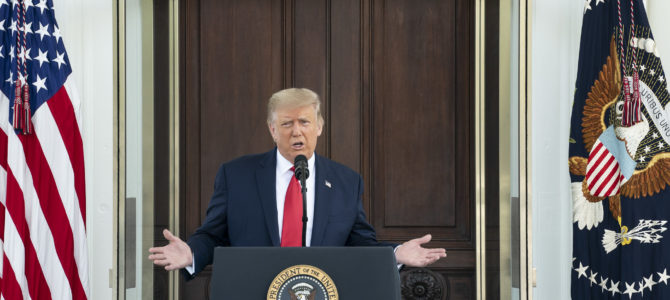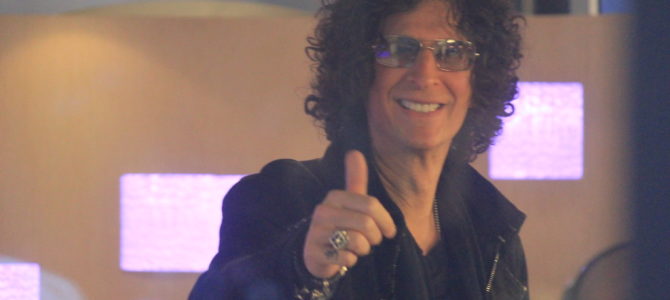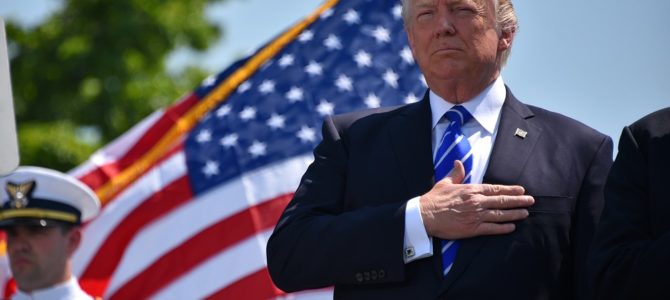
Donald Trump is the candidate of the white working class. His popularity with this cohort was recognized early in his candidacy. The preponderance of commentary on the Trump phenomenon since then, whether favorable to the tumescent real-estate mogul and reality television star or not, has proceeded from this assumption.
These analyses affirm Trump’s allure to white, working-class voters as central to his candidacy. It is the pillar on which his dominant standing in the polls rests. If Trump wins the Republican nomination, it will be through their support.
Yet these analyses, revealing as they are, overlook a salient fact. The verdict of working-class voters will not be the only one rendered on Trump, or the most important one. However popular Trump may be with the working class, he is as unpopular with voters who have graduated from college, a group without whose backing the GOP has no shot at regaining the White House.
Trump does respectably among college-educated Republicans. In Quinnipiac University’s most recent poll of the Republican race, Trump received the support of 30 percent of respondents who had a college degree, more than any other Republican. This was an improvement from earlier this month, when Trump trailed Marco Rubio in this demographic. But if three-tenths of college-educated Republicans back Trump, then seven-tenths of them don’t. To put it another way: the vast majority of Republicans with college degrees oppose Donald Trump.
Let’s Compare Donald Trump to Everyone Else
Trump does have a positive favorability score among college Republicans of 55 to 37 percent. Yet his net rating is the lowest of any GOP candidate. Ted Cruz (61 to 27 percent), Marco Rubio (75 to 15 percent), and John Kasich (62 to 9 percent) all best Trump on this measure.

Trump also does worst on the question of which candidate “you would definitely not support for the Republican nomination for president.” Twenty-eight percent of all Republican voters would refuse to back him, which improves to 26 percent when only Republican college graduates are considered.
Trump has a hard ceiling with the latter group that manifests in survey after survey. College graduates constituted 54 percent of Republican turnout in the New Hampshire primary. Trump won this group with 29 percent of the vote. This is a good number. But it also means the other 71 percent went for Trump’s rivals.
In Iowa, Trump fared worse. College graduates made up 51 percent of the GOP caucus electorate. Trump could do no better than third, winning 21 percent of college-educated Iowa Republicans. Both Rubio (28 percent) and Cruz (25 percent) bested him in this crucial demographic. All told, fourth-fifths of Iowa Republicans who graduated college opposed Trump. As Tim Alberta notes in his exegesis of the exit polls from the first two nominating contests, these results suggest “the formation of an anti-Trump coalition among college-educated Republicans.” Trump’s “weak link,” as Ron Brownstein calls it, followed him to South Carolina, where Rubio beat Trump 27 to 25 percent among voters with at least a four-year degree.
There is no reason to believe Trump’s fortunes with college-educated Republican voters will improve—and this is just Republicans. With college-educated voters as a whole, Trump is poison. Pure, lethal poison.

The preceding chart, also drawn from Quinnipiac’s latest polling, is illuminating. For one thing, it shows that Hillary Clinton, the frontrunner for the Democratic nomination, is 13 points underwater with college-educated voters. Yet she is a homecoming queen compared to Trump, who is an unfathomable 37 points in arrears with college-educated voters. Cruz is also anathema to college graduates. They even look askance at Rubio now, while earlier this month they were enamored of him. Only Bernie Sanders gets positive marks from this group.
A candidate’s standing with college graduates is significant because it correlates with how well he or she performs on head-to-head ballot tests against other candidates. Here the news is no better for Trump. He would get crushed among college voters, and consequently lose the election.

This chart reveals just how poorly Trump would do with college graduates against Hillary Clinton. While he loses to Clinton by one point overall, his deficit soars to 15 points with college graduates. This is a gap Trump’s vaunted working-class support can’t fill. According to Quinnipiac, he only leads by five points with voters who don’t have college degrees, 45 to 40 percent.
Cruz, not usually categorized as a champion of the working class, does better with them against Clinton than Trump does. The Texas senator gets 48 percent of working-class voters to 39 percent for the former secretary of state. His deficit among college voters is only 13 points (52 to 39 percent), though, so he leads Clinton 46 to 43 percent. Rubio polls best against Clinton with both groups, trailing 40 to 46 percent with college voters and leading 50 to 37 percent with non-college voters. This translates to a 48 to 41 percent lead for the Florida senator overall.
College-Educated People Vote More
The “diploma divide” among Republican voters was a key factor in the 2012 primary, and it has recurred in 2016. In 2012, college-educated Republicans lined up behind Romney, while those without degrees fragmented among several candidates. But in 2016, as David Wasserman noted in December, it is college-educated Republicans who have divided their support while those without degrees have coalesced behind Trump. Consequently, Trump leads the GOP field because even though he gets only a quarter of Republicans who graduated from college, he gets two-fifths of those who didn’t.
The problem for Trump (or any candidate) is that winning non-college graduates while losing degree holders does not a winning coalition make. All it does is guarantee defeat. Per the 2012 exit polls, Romney won college graduates 51 to 47 percent over President Obama. It was the only educational cohort Romney won on his way to a four-point loss.
Trump supporters might counter that he would make up for it by winning overwhelming support from working-class voters. This is wrong for two reasons. The first reason is that, as seen in the Quinnipiac poll, Trump only breaks even with non-college graduates in the general election. The second reason is that there simply aren’t enough working-class voters to make up for the catastrophic losses among college-educated voters Trump is destined to incur.
Voting propensity is strongly correlated with educational attainment. The more educated one is, the more likely one is to vote. Unsurprisingly, therefore, the two most reliable voting groups in the United States are voters with bachelor’s degrees and those with post-graduate degrees. The following chart, drawn from the 2012 election review by the Census Bureau’s Current Population Survey, shows that these two groups turned out at rates of 75 percent and 81 percent, respectively. Even those who attended but did not finish college had a voting rate higher than 60 percent. The rate for high school graduates was just over 50 percent, and it declined sharply for those who did not finish high school.

There is simply no way a candidate can win a presidential election now by losing the biggest turnout group by ten or more points, as polls consistently show Trump doing. College graduates cannot stand Trump, and this surely is no small factor in him having the highest negative rating of any presidential candidate Gallup has ever tested. Sixty percent of Americans have an unfavorable view of Trump. That kind of radioactivity usually requires a Geiger counter to measure.
College graduates vote more, and there are more of them who vote. According to the 2012 exit polls, 47 percent of voters had at least a four-year degree. Another 29 percent spent at least some time enrolled on campus. That adds up to 76 percent. The overlap is not perfect, but if working-class voters are defined as voters with no more than a high school education, then Trump’s hopes rest on taking larger and larger bites from a cherry.
Donald Trump’s Missing White Voters
Even the pit has been consumed. Psephologists and pundits have fixated on “the mystery of the missing white voters” ever since Sean Trende noticed their disappearance after the 2012 election. In a recent series on the Trump phenomenon, Trende posits that the candidate most likely to appeal to these missing voters is Trump, as they were, for the most part, rural blue-collar whites with an affinity for populism who in another age voted for Ross Perot.
As Nate Cohn puts it, Trump’s base consists of irregularly voting nominal Democrats from the industrial north, the South, and Appalachia. The problem, Trende writes, is that there simply aren’t enough of them to win even if you hold everything else constant. The alternatives are either to win more non-white support or increase the GOP’s already staggering edge with white voters.
There’s the rub. Trump could theoretically get more non-white voters (perhaps by appealing to black voters more than Romney did). Or, more plausibly, he could boost turnout among blue-collar whites with his stances against free trade and immigration. But he would do so almost certainly at the expense of support from white-collar voters.
Liam Donovan framed the dilemma well in a recent article in National Review: “Trump can run up the popular-vote score all he wants riding white-working-class resentment. It won’t help him when he gets buried in swing counties such as Fairfax, Hamilton, Hillsborough, and Arapahoe. Sure, he can target the Rust Belt, but big margins in Western Pennsylvania or the Upper Peninsula won’t matter if he can’t play in Bucks or Oakland Counties.”
Trump won’t play in Bucks County. He won’t for reasons Trende articulates in the final part of his excellent series. He argues that Trump is the avatar of what he labels “cultural traditionalism.” Cultural traditionalists share certain attitudes “about the importance of family, religion, achievement, intellectual advancement, diversity (at least within categories deemed important by elites), patriotism, and nationalism” distinct from, and often diametrically opposed to, those of their counterparts, the “cultural cosmopolitans.”
The GOP establishment is made up for the most part of cultural cosmopolitans, while many of its voters are cultural traditionalists. Out of this untenable tension sprang Trump. The cultural traditionalists love him not least because he is a giant middle finger to the cosmopolitans.
The nation’s metropolitan areas and suburbs, though, are populated by cultural cosmopolitans, affluent, college-educated professionals who cringe whenever Trump promises to ban Muslims or deport every illegal immigrant in the country. As we have already seen, there are, at least in voting terms, more cultural cosmopolitans than there are cultural traditionalists, and by a considerable margin. As we have also seen, they loathe Donald Trump. They are never going to vote for someone who so grievously offends their sensibilities.
Evidence Trump Haters Won’t Switch Sides
A Trump backer might rejoin that I am merely speculating that college-educated Republicans would not flock to Trump if he became the nominee. Supporters of one candidate during a primary often say they won’t support his opponent but rally around the party flag for the general election. This is a fair point. It is hard to prove a negative, especially one that hasn’t happened yet. There is some evidence, however, to indicate Trump may not benefit from this normal pattern.
There are few analogues to Trump in recent years. One who resembled the magnate, at least in his capacity for intemperate remarks, was Todd Akin. In the last poll conducted before he devoured his leg, Akin led his 2012 Missouri Senate race against incumbent Claire McCaskill by 11 points. This included a one-point advantage with college graduates, 46 to 45 percent. Yet on Election Day, Akin lost college graduates 50 to 44 percent, a seven-point swing. Moreover, 15 percent of Republican voters defected and voted for McCaskill.
Another GOP Senate candidate who made foolish remarks about abortion in 2012 was Richard Mourdock of Indiana. He managed to win college-educated voters, but like Akin he bled considerable Republican support: 14 percent of Hoosier Republicans backed Democrat Joe Donnelly, who won.
In 2010, Sharron Angle, the controversial GOP Senate nominee in Nevada, lost 11 percent of Republicans to Harry Reid. Her Colorado counterpart, Ken Buck, saw 10 percent of Republicans shift to Michael Bennett.
Most instructive, perhaps, is the 2008 presidential election, which saw Barack Obama win 9 percent of Republicans and an astounding 20 percent of self-described conservatives. Given the aspirational qualities of Obama’s candidacy, we should not be surprised he had so much cross-ballot appeal. Nine or 10 percent is not much in a decisive contest like his first presidential campaign, but in a close election or a swing state it could be the difference between victory and defeat.
Donald Trump Means the End of the Republican Party
Trump doesn’t make inflammatory comments about rape or abortion. That’s because he’s too busy making them about everything else: immigration, foreign policy, economics, his rivals, journalists, you name it. His peanut gallery roars, but the rest of the country is unimpressed. A Trump-inspired descent into white identity politics would be a cataclysm for the GOP because it would alienate the very voters it needs if it wants the White House back. It must get at least a few voters for whom cultural affinity outweighs partisan affiliation. There is no way to win without them. Trump’s campaign, on the other hand, depends on pursuing voters who don’t exist at the cost of those who do.
It is well and good to appeal to the working class. It behooves the GOP to do so. There is great merit in criticizing the GOP and its leadership and policy cadres, which often seem to care about little more than hunting such mythical beasts as the flat tax while pretending to pay lip service to any number of causes dear to its rank and file. I have myself avowed that the GOP establishment (and donor class) deserve “incineration.” But Trump should not be the instrument of vengeance. For that sword, once drawn, will be sheathed only with difficulty.
By now you have surely begun to suspect that I oppose Trump. You’re right. I oppose him on philosophical and ideological grounds. But I also oppose him for practical reasons. Nominate Trump, and the GOP would lose college-educated voters for at least a generation, and possibly forever. With them would go the prospect of ever again winning states like Colorado, Pennsylvania, Ohio, and Florida. So, without them, would the GOP be finished as a national party, and perhaps as any kind of party at all.
The data speaks in a clear voice and it speaks a simple message: the Republican Party can have Donald Trump or it can have a future, but it cannot have both.









